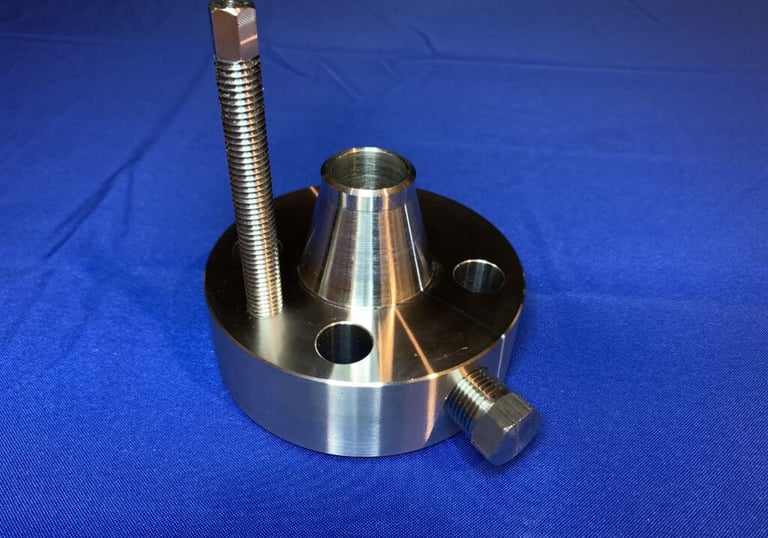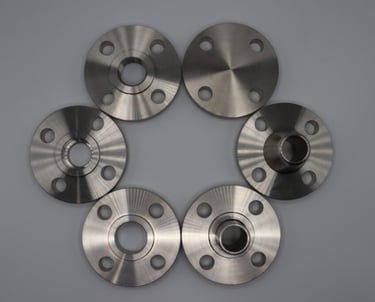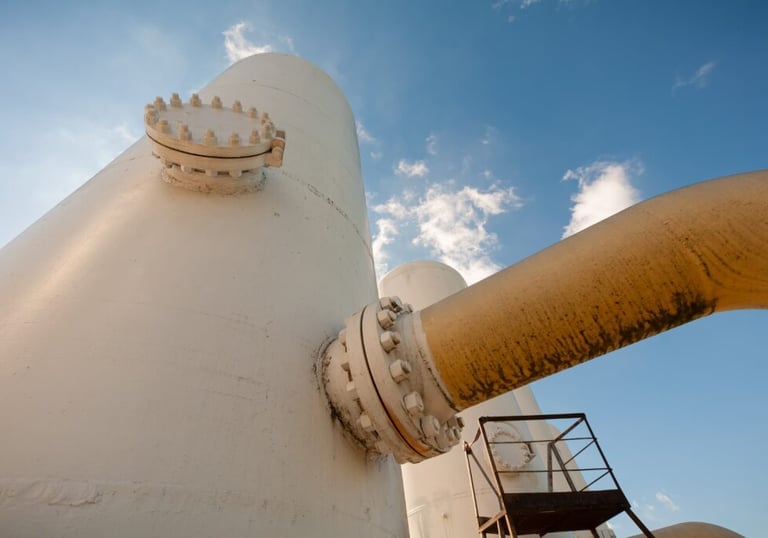Industrial Pipe Flange Essentials
In complex sectors like oil and gas, petrochemical, waterworks, and power generation, the right connection is mission-critical. A single industrial pipe flange is more than just a piece of metal; it's a vital component for ensuring safety, efficiency, and operational integrity.
What is an Industrial Pipe Flange?
An industrial pipe flange is a forged, cast, or cut ring or disc used to connect pipes, valves, pumps, and other equipment, forming a complete piping system.
Think of them as the critical connectors that hold industrial plumbing together. They are typically bolted together with a gasket placed between them to create a secure, tight seal. This design offers a significant advantage: it allows for easy disassembly.
Unlike welded connections, which are permanent, a flanged joint can be opened for maintenance, inspection, cleaning, or modification without cutting the pipe


Why and Where Are Flanges Used?
Industrial pipe flanges are the backbone of heavy industry. Their use is non-negotiable in any high-pressure, high-temperature, or critical containment system.
The "Why": Primary Functions
Ease of Maintenance: This is the #1 reason. Flanges allow sections of pipe, valves, or equipment to be removed for repair or replacement without disrupting the entire system.
Creating Connections: They join pipes to other pipes, or more commonly, to specialized equipment like valves, vessels, or pumps.
Terminating a System: A "blind flange" is used to seal the end of a pipe or vessel, acting like a high-strength, removable cap.
Joining Dissimilar Materials: Flanges make it simple to connect a pipe made of one material (like stainless steel) to a valve made of another (like cast iron).
Handling High Pressure: A properly bolted and gasketed flange creates an incredibly strong, reliable seal capable of withstanding immense pressure and temperature.
The "Where": Key Industries
You will find industrial pipe flanges in virtually any demanding environment, including:
Oil and Gas (Upstream, Midstream & Downstream): From wellheads and pipelines to refineries, flanges are essential for handling volatile crude oil and natural gas.
Petrochemical and Chemical Processing: Safely containing and transporting corrosive or hazardous chemicals.
Power Generation: In fossil fuel, nuclear, and geothermal plants that rely on high-pressure steam.
Waterworks and Municipal: Used in large-scale water treatment plants and distribution systems.
Food and Beverage: Specialized sanitary flanges are used for systems that require frequent cleaning.
Manufacturing and Industrial Process Piping: Any factory that uses pressurized air, water, or other fluids.








What Are the Most Common Types of Flanges?
While there are many specialized types, most flanges fall into a few key categories. The type used depends on the pressure, temperature, and nature of the connection.
1. Weld Neck Flange
Considered the "high-performance" industrial pipe flange. It features a long, tapered hub that is butt-welded directly to the pipe. This transfers stress from the flange to the pipe itself, providing superior strength in high-pressure and high-temperature applications.
2. Slip-On Flange
This industrial pipe flange is "slipped" over the end of the pipe and then welded in place from both the inside and outside. It is generally easier to align and less expensive than a weld neck, making it popular for lower-pressure, less critical applications.
3. Blind Flange
A solid disc with bolt holes but no center bore. Its sole purpose is to seal the end of a piping line or a vessel port, acting as a high-strength, removable cover.
4. Threaded Flange (or "Screwed" Flange)
These industrial pipe flanges have threads cut inside the bore and are screwed onto a pipe that has matching male threads. They are used in systems where welding is dangerous or impractical (e.g., in highly explosive areas).
5. Socket-Weld Flange
Similar to a slip-on, but the pipe is seated into a "socket" on the flange. It is then fillet-welded around the outside. This is typically used for smaller-diameter, high-pressure pipes.
6. Lap-Joint Flange
This is a two-part system used with a "stub end." The flange itself is loose and slips over the pipe, while the stub end is welded to the pipe. The industrial pipe flange then rotates freely, which is extremely helpful for aligning bolt holes in a complex system.


What Materials and Sizes Do They Come In?
Flanges are made from a wide variety of materials to match the pipes and a range of temperatures, pressures, and corrosive environments.
Common Materials
Carbon Steel (e.g., A105, A350): The most common and cost-effective material. Used for general-purpose applications in moderate temperature and pressure environments.
Stainless Steel (e.g., 304/304L, 316/316L): The primary choice for corrosion resistance (e.g., in chemical plants or water treatment) and for high-temperature applications.
Alloy Steels (e.g., F11, F22): Contain other elements (like chromium, molybdenum) to provide superior strength in very high-temperature and high-pressure services, like power plants.
Exotic Alloys (e.g., Inconel, Monel, Hastelloy): Used for severe-service applications involving extreme corrosion, high temperatures, or both.
Cast Iron: Common in low-pressure municipal water systems.
Sizes and Standards
Flanges are defined by two primary (and equally important) measurements:
Nominal Pipe Size (NPS): This is the "size" of the flange, corresponding to the pipe it fits (e.g., 2", 12", 24").
Pressure Class: This is a rating (not a direct measure of PSI) that defines its ability to handle a range of pressures at various temperatures. Common classes include 150#, 300#, 600#, 900#, 1500#, and 2500#. A 300# flange is "stronger" and heavier than a 150# flange of the same size.
All of these dimensions, materials, and ratings are governed by global standards, most commonly ASME B16.5 (for flanges up to 24") and ASME B16.47 (for larger flanges).
How Do I Find the Right Flange or Supplier?
Choosing the correct industrial pipe flange is critical for safety and system integrity. You must always know five key pieces of information:
Pipe Size (NPS)
Pressure Class (e.g., 150#, 300#)
Flange Type (e.g., Weld Neck, Slip-On)
Material Grade (e.g., A105 Carbon Steel)
Flange Face (e.g., Raised Face, Flat Face)
When sourcing components, it is crucial to work with a trusted industrial pipe flange supplier or flange distributor. A reliable partner ensures you receive certified materials that meet all required standards (like ASME and ASTM), preventing catastrophic failures and ensuring the long life of your system.
Try Texas Flange, a top industrial pipe flange supplier in Texas. Contact the sales team today or visiting their website here:

